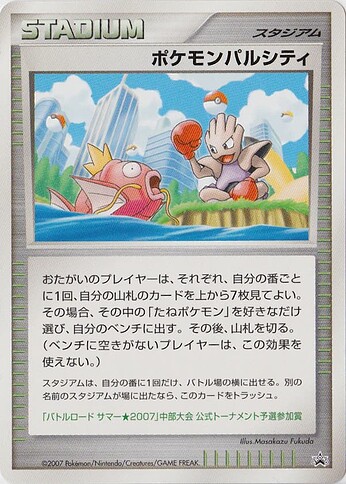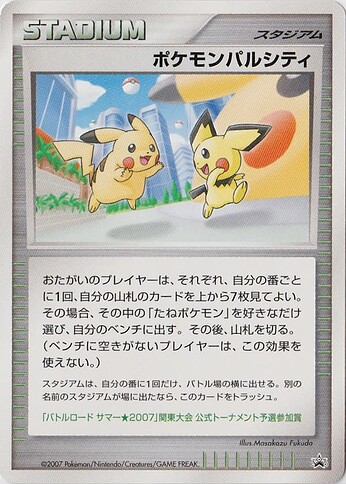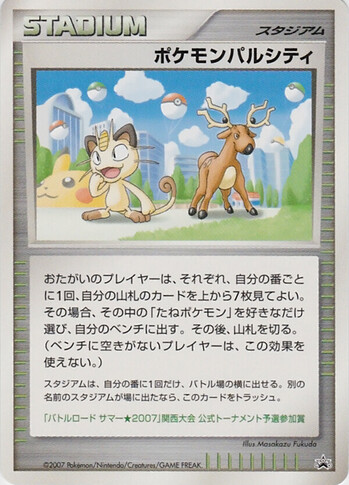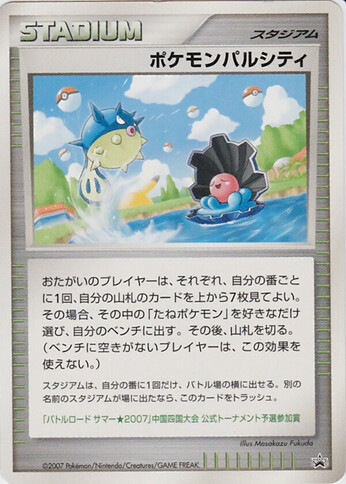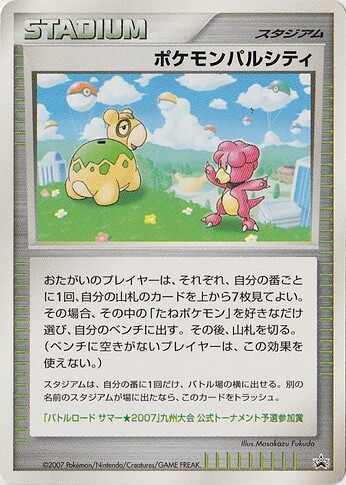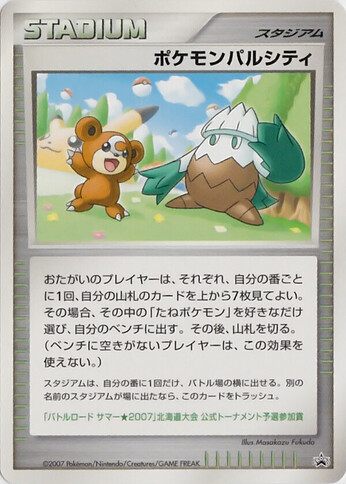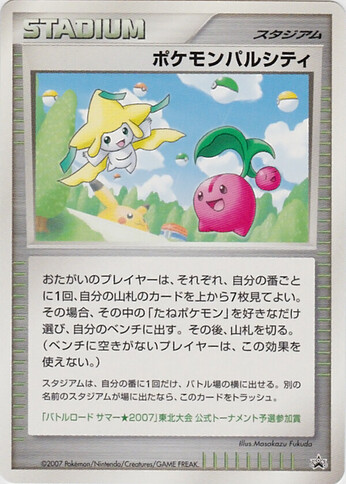This brief article is to understand the distribution and in turn the population of the Pokemon Pal City Promos. The Pokemon Pal City promos are a special set of 7 Japanese exclusive promos cards released in the year 2007.
Pal City
| Card | Set |
|---|---|
| Pal City Chubu (Magikarp & Hitmonchan) | Unnumbered promo |
| Pal City Kanto (Pikachu & Pichu) | Unnumbered promo |
| Pal City Kansai (Meowth & Stantler) | Unnumbered promo |
| Pal City Chugoku (Clamperl & Qwilfish) | Unnumbered promo |
| Pal City Kyushu (Numel & Magby) | Unnumbered promo |
| Pal City Hokkaido (Teddiursa & Snover) | Unnumbered promo |
| Pal City Tohoku (Jirachi & Cherubi) | Unnumbered promo |
What makes these cards special (personal opinion):
-
Japanese exclusive promo cards.
-
Every event location had a different illustration and probably depicted the region where the event was held.
-
Every card has a Pikachu dome illustrated which was present at the event locations.
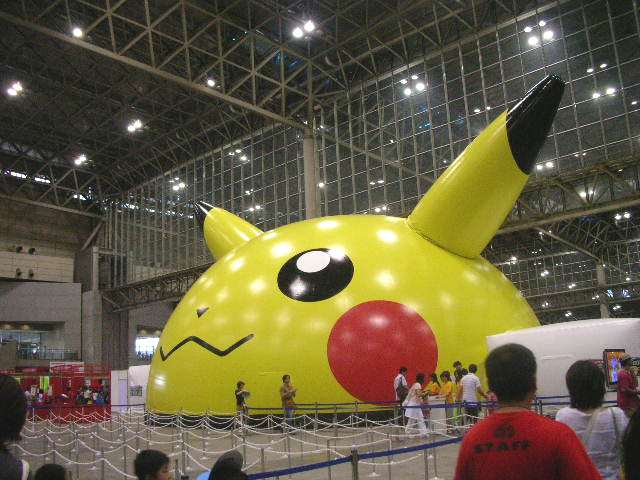
- The bottom of each card (green text) also mentions ‘Battle Road Summer 2007 – Location of the tournament venue – Preliminary Participation Award’. This helps commemorate each card and also the fact that a lot of history lies behind the release.
These promo cards could be obtained at 3 events
-
Tournament participation award for the ‘Battle Road Summer 2007’ Event.
• Focus of this article – discussed in section below -
Gym Challenge tournament to commemorate the release of DP4 - Moonlight Chase/Dawn Sprint.
• Commemoration tournament held in toy stores and card game shops nationwide to celebrate the release of Moonlight Chase / Dawn Sprint (月光の追跡・夜明けの疾走)
expansion packs for DP4. If a contestant was to win first place in this tournament, they would then receive a complete sealed pack of all 7 promo cards, regardless of the regions this tournament was played. -
Gym Official – elimination battle corner, “Tag Battle DP” – 7 venues nation wide on September 9th
• Lucky draw lottery. For every 500 Yen on Pokemon card games and Pokemon card game-related products at Gym☆Official stores on the day of the event, you were eligible for a lottery ticket and the set of 7 promos from the Pokemon Pal City were one of the raffle prizes.
Since participating in the 2 Gym Challenge events grants the winner the full set of 7 cards, for the purpose of this article, these events are not relevant because the distribution of the cards is equal. The total number of complete sets distributed across both the event is unknown and probably not possible to establish.
An attempt to understand how these cards were distributed is based on the first event, ‘Battle Road Summer 2007’ where these promos were first introduced and distributed. This event was held from July 15th 2007 until September 2nd 2007 and was held across 8 different locations with the Kanto region being split into 2 different venues A and B.
If you participate in an official tournament at any of these events, you were eligible to receive a participation award card irrespective of the results. Every promo card was a venue-limited stadium card with a different illustration depending on the location of the venue. For a detailed and in-depth information on the whole Battle Road 2007 event, please refer to the excellent article by Pokumon.
WHY
I have been very much fascinated by this promo card set and these are one of my favorites in the hobby. However, I always found that some cards are very easy to find than others. I always noticed that the Pal City Chubu (Magikarp & Hitmonchan) and Pal City Kanto (Pikachu & Pichu) were always in abundance and at a great price, but I could barely manage to find the other cards. Even if they did surface and there are copies on the market, the price is a bit too steep to my personal liking.
This is the PSA Pop data, since it is easy to visualize what is being stated. Does not indicate the rarity of the cards themselves.
| Card | Total Population |
|---|---|
| Pal City Chubu (Magikarp & Hitmonchan) | 206 |
| Pal City Kanto (Pikachu & Pichu) | 140 |
| Pal City Kansai (Meowth & Stantler) | 80 |
| Pal City Chugoku (Clamperl & Qwilfish) | 46 |
| Pal City Kyushu (Numel & Magby) | 44 |
| Pal City Hokkaido (Teddiursa & Snover) | 41 |
| Pal City Tohoku (Jirachi & Cherubi | 36 |
I have tried to find an explanation from various people who have heard and known about these promo cards, but like myself, others also did not have a definitive answer to why some cards were available much more than others. Was it the size of the venue? Size of the region? Did a lot more people attend the tournament etc.
Tournament Structure
The answer lies in how the tournament was structured.
| Venue | Max Participants in Final Round | Time for preliminary - Junior | Time for preliminary - Senior / Masters |
|---|---|---|---|
| Chubu | 64 | 3 session - 5.5 hour timeframe | 3 session - 6.5 hour timeframe |
| Kanto A | 64 | 3 session - 5.5 hour timeframe | 3 session - 6.5 hour timeframe |
| Kanto B | 64 | 3 session - 5.5 hour timeframe | 3 session - 6.5 hour timeframe |
| Kansai | 64 | 3 session - 5.5 hour timeframe | 3 session - 6.5 hour timeframe |
| Chugoku | 32 | 1 session - 3 hour timeframe | 1 session - 3 hour timeframe |
| Kyushu | 32 | 1 session - 3 hour timeframe | 1 session - 3 hour timeframe |
| Hokkaido | 32 | 1 session - 3 hour timeframe | 1 session - 3 hour timeframe |
| Tohoku | 32 | 1 session - 3 hour timeframe | 1 session - 3 hour timeframe |
The above table shows in brief the tournament structure across the different venues. Let me elaborate.
This particular Battle Road event was one of the first times that you could not pre-register for the tournament. All entries were accepted on the day of the event on a FIRST COME FIRST SERVE basis. There was a priority entry allotted from 8-30am in the morning to 11-30am for participants where you can do a quick deck registration and head on to participate.
You were also allowed to participate as many times as you like as long as you have not placed in the top 3 at any another venue.
However, for every venue, there were 2 differentiating factors:
-
Maximum number of players which can participate for the final round – meaning, the preliminary round would conclude when the max players for the final round had qualified.
-
The number of consecutive rounds of victory needed to qualify for the final round. This number was between 1-5 and was always venue dependent. By various blog post sources, for some tournament you had to win 3 consecutive games, for some you had to win 4 games.
I believe these 2 factors contributed to how the promo cards got distributed.
A higher player cap meant a lot more participants, thereby, larger number of these cards being distributed. Also, the higher number of wins needed meant that more people crash out with one loss, register again** and go through the gauntlet.
This means that the venues with lower max final round participants which in turn also had a lower consecutive victories needed, had a much lower card distribution. High likely scenario that the max player limit for the final rounds were filled faster, thereby eliminating larger/ repeat participation.
Therefore we clearly see that the Pal City cards from Chugoku, Kyushu, Hokkaido and Tohoku are significantly rarer** than the Chubu, Kanto and Kansai.
Venues of Chubu, Kanto and Kansai also split the qualifying rounds in multiple sessions across 2 days. Meaning day 1, only maximum of 32 players would be qualified, the other 32 will be filled on the second day. Various tournament blog posts suggests that longer tournaments lead to better development of the game meta, deck variety and better planning from players.
Conclusion
So there you have it. A bit more understanding on why some of the Pal City cards are much more rarer and harder to obtain than the others. The answer lies within how the tournament was structured.
Disclaimer
** When it is mentioned rarer in the article, it is in context of the other Pal City promo cards. However, I believe all of the Pal City cards are not in great abundance and are rare as promo cards go. The total number of cards distributed for each is impossible to determine.
** While researching for the article I was not able to establish any information on whether, if the same player registered again after losing one of the games, will they be given another card for participation or have to be happy with the one they already received the first time they registered.
Lastly, apologies for a very wordy article. I would love to discuss more if you have any questions or comments - Cheers!
Sources
-
https://web.archive.org/web/20071013231551/http://www.pokemon-card.com/info/entry/071012_177.html
-
https://web.archive.org/web/20070911115527/http://www.pokemon-card.com/info/entry/070907_139.html
-
https://web.archive.org/web/20070701021831/http://www.pokemon-card.com/event/070622.html
-
https://pokeboon.com/jp/promo_event/battle-road-summer-2007/
